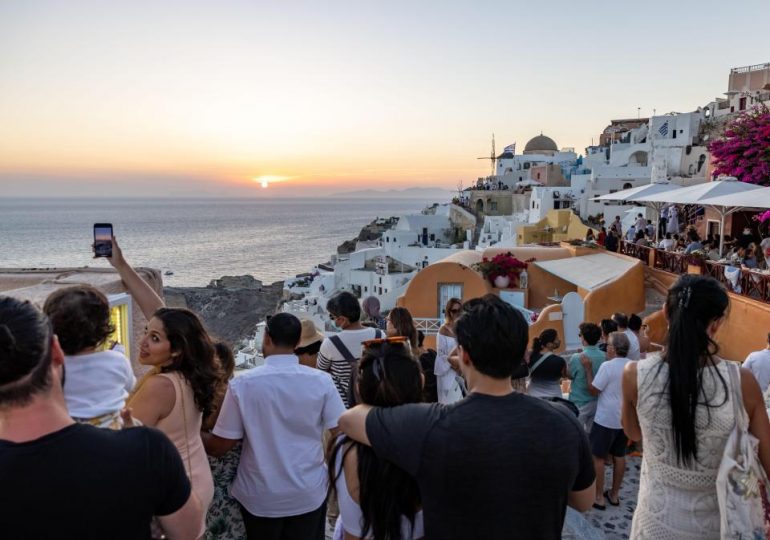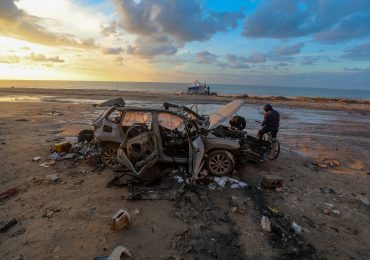GREECE will scale back the number of cruise ships visiting its “over-saturated” islands as part of a major crackdown on tourists.
The Balkans nation is determined to rid of the hordes of Instagrammers who travel to its summer hotspots over fears of some islands buckling under the pressure of overtourism.
AlamyThe beautiful Greek island of Santorini has become flooded with Instagrammers searching for the perfect selfie[/caption]
AlamyMykonos isn’t much better off, with its streets becoming rammed with tourists[/caption]
GettyThe tiny paradise islands have been over-saturated with tourists making life difficult for locals[/caption]
AlamyGreece’s prime minister is now keen to reduce the number of cruises visiting Santorini and Mykonos[/caption]
Greece’s prime minister has declared that popular destinations such as Santorini and Mykonos will be prioritised because they are “suffering” the most.
Kyriakos Mitsotakis said plan is now in place to protect the islands, with measures to be introduced to reduce the number of visiting cruise liners.
“I think we’ll do it next year,” he told Bloomberg.
He added that the number of berths or anchoring slots could also be reduced.
Last year, nearly 750 cruise ships visited Mykonos, a whopping 23 per cent increase on the year before.
Known for its summer party atmosphere, sandy beaches and luxury accommodations, the island is continuously swarmed by Brits and other nationalities each year.
However, it is the ever so slightly smaller island of Santorini that is the most affected by the rising number of visitors.
“Santorini is the most sensitive, ” Mitsotakis told Bloomberg. “Mykonos will be second.”
Greece’s tourism industry played a major factor in the nations economic recovery following a decade of debt.
Tourism currently accounts for around a quarter of its economic output, while the country has smashed records for tourist visits and spending in the post-Covid era.
But the impact of visitors is starting to have a negative effect.
Greece welcomed 32.7 million tourists in 2023, 18% more than the year before, while the first quarter of 2024 has seen a nearly 25% rise in visitors.
Cheap flights are arguably the biggest reason behind a surge in tourist numbers in recent years but the impact of social media has also proven to be influential.
Greek islands are renowned for their beauty and it is influencers who are the main culprits for promoting this online.
In turn, this leads to their thousands of followers wanting a slice of the picturesque scenery themselves.
Santorini, in particular, is a haven for social media clout.
Its whitewashed terraces and balconies that overlook its incredible surroundings are often littered with selfie-taking Instagrammers desperate for the perfect sunset shot.
Santorini’s 15,000 inhabitants are beginning to buckle under the pressure of the major increase in visitors, with an estimated 5.5million tourists visitng the island each year.
While Greece is keen to avoid another economic crisis at all costs, Mitsotakis is prepared to cut visitor numbers to protects these islands.
“Santorini in itself is a problem,” Greece’s prime minister said, before adding that the huge number of visiting vessels may not bring commensurate economic benefit.
Why Santorini and Mykonos have become so popular
By Tom Malley
Santorini and Mykonos are two of Greece’s most popular islands thanks to their stunning scenery, sandy beaches and idyllic locations.
Party lovers from across the globe also love flocking to the islands to spend a vacation filled with memorable nightlife experiences.
Social media influencers also play a big part in the number of visitors to Santorini and Mykonos.
By showing off the islands best bits to their thousands of followers, they encourage others to visit themselves.
Cheap flights can also be found to bothb locations, providing more incentive for Brits and others to travel to the luxury locations.
Averaging daily temperatures of around 29 degrees during the summer, it’s the perfect location to escape the miserable weather back home.
GettyParty-central Mykonos is popular with Brits[/caption]
AlamyVisitors to both islands become obsessed with snapping themselves amongst its picturesque views[/caption]
AlamyPicturesque views can be found in abundance in Santorini[/caption]
“There are people spending a lot of money to be on Santorini and they don’t want the island to be swamped,” Mitsotakis said. “Plus the island can’t afford it, even in terms of security.”
As for party-centric Mykonos, 749 cruise ship visits were recorded in 2023 – second only to Santorini and an increase of over 23 per cent from 2022.
It comes as a wave of anti-tourism protests sweep across some of Europe’s most popular holiday hotspots.
Last month, anti-tourist graffiti appeared in Athens as the Greek capital called for an end to “over-tourism.”
The sunny mainland city, home to the iconic Parthenon, has seen an increase in bitter graffiti messages urging tourists to “go home” – similar to the ones that have appeared in Spain in recent months.
Protests have been rife across the Mediterranean nation in particular, with residents of Mallorca and Ibiza sending out strong messages of late.
Demonstrations have taken place on beaches across the island with locals protesting over excess tourism.
Locals have even threatened to block the island’s airports and protest outside hotels.
Campaigners claim mass tourism is causing housing shortages, major environmental damage, and driving down wages.
Anti-tourist measures sweeping hotspots
MENORCA and Majorca are just some of the European hotspots implementing anti-tourist measures.
Many top holiday destinations across the continent are taking action to prevent unwanted travellers from taking over their towns and cities.
Locals feel they can no longer live in the iconic destinations because they have become overcrowded, unsafe and uncomfortable.
They say there are too many cars on the roads, traffic congestion, overcrowded beaches, blocked access roads, ruined beauty spots and just too many holidaymakers flocking to the island which expects record figures this summer.
In April, thousands of people took to the streets in Tenerife to demand restrictions on holidaymakers after telling Brits to “go home”.
The anti-tourist hordes filled a square in the capital brandishing banners including some that read “You enjoy we suffer” in English.
Protests also took place at the same time on other popular Canary islands including Lanzarote and Gran Canaria.
The marches were organised under the slogan “The Canary Islands have a limit.”
Hotel bosses in Benidorm have even admitted they are “very worried” by the anger growing amongst island residents but branded holiday homes in Spain a “virus”.
More recently, the Committee on Tourism, Trade, Employment, Culture and Sport reportedly approved an initiative to reintroduce a cap on cruise ships to Palma, Majorca’s capital.
Politicians are keen to implement a new set of rules on cruise ships in terms of taxation, the environment or the use of less polluting fuels to lower numbers coming into the Balearics.









